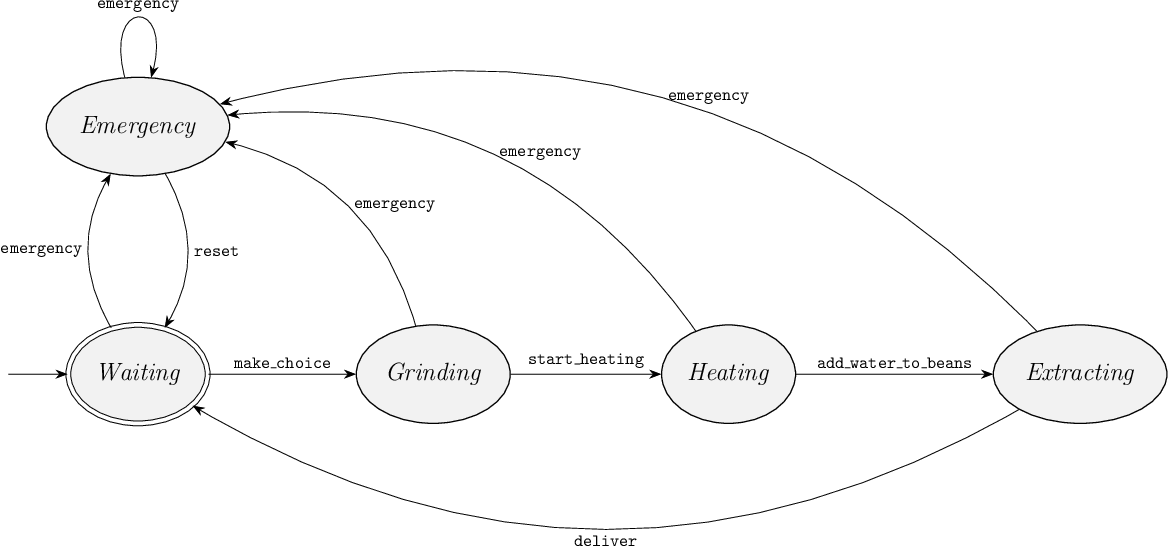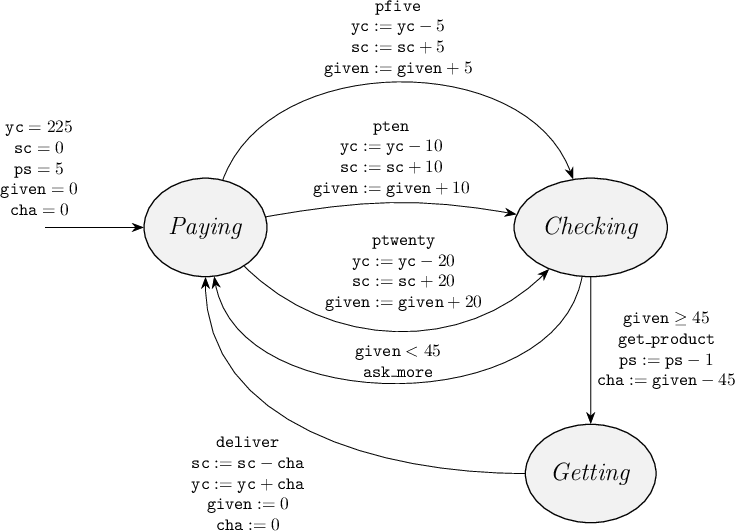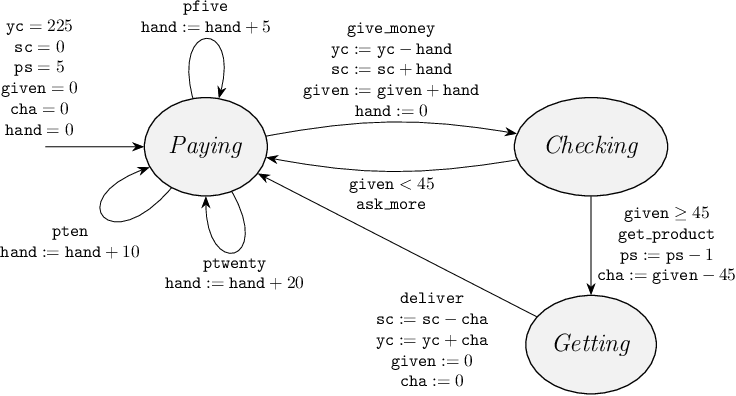Module 1.5: Exercises
You will now practice what you have learned in this first module. When modeling, there is generally not one correct answer, as multiple solutions are possible. After you complete an exercise, an example solution is given, together with an explanation.
Exercise 1
A vending machine will give you the snack that you want, after you give it a coin (event give_coin).
If you put in an additional coin, while it is processing your order, it will reject this coin and give it back (event reject_coin).
Once the vending machine has delivered your order (event deliver), it will accept a next coin.
Model this vending machine using an automaton, by drawing it on paper. First, think of appropriate events and locations. Then, consider which locations should be initial and marked.
The machine is initially waiting for a customer to enter a coin, in location Waiting.
Once it is given a coin, it is busy getting your order and will not accept another coin, in location Busy.
If another coin is given, the automaton goes to a third location, Rejecting.
In real life, the machine will only be in this location for a fraction of time, as it will immediately reject the second coin once it is given.

Exercise 2
A coffee machine is initially waiting for an order. It requires input on what type of coffee it needs to make. Upon receiving an order, the coffee machine starts grinding the coffee. The machine heats the water subsequently and adds the water to the grinded coffee beans to extract the coffee from the beans. After delivering the coffee to the cup, the machine returns to waiting for an order. An emergency stop button can be pressed to stop the coffee machine directly, independent of its current state. Each time the coffee machine goes into emergency mode, it needs to be reset before it can start waiting for an order again.
Model this coffee machine using an automaton, by drawing it on paper.
The coffee machine is initially waiting for customers to enter their choice.
Once a choice is made, it grinds the beans, heats the water and puts the two together to extract the coffee from the beans.
Appropriate events are make_choice, start_heating, add_water_to_beans, deliver, emergency and reset.
Appropriate states are Wait, Grind, Heat and Extract.
You can, of course, name them differently.
The emergency mode is modeled using location Emergency.
The event emergency leads to this location, from every location.
It is also possible to push the emergency stop button while the coffee machine is in emergency mode, so a self loop edge is needed for the emergency event in the Emergency location.
Appropriate marked locations are Wait and Emergency (either or both).

Exercise 3
Two persons, A and B, can use a bicycle.
Only one person can use the bicycle at a time.
Person A can start riding the bicycle by event ride_A, and similarly person B can start riding it by event ride_B
When the person riding the bicycle is done riding it, the corresponding event leave_A (for person A) or leave_B (for person B) occurs.
Model this bicycle using an automaton, by drawing it on paper.
It is essential that the two persons don't use the bicycle simultaneously. So, a person needs to leave the bicycle, before the other person can start riding it. A person may also leave the bicycle and then start riding it again.

Exercise 4
Model a counter that counts from zero to 4.
The increment event increments the counter, and the decrement event decrements it.
The counter is connected to a lamp, and it should be possible to turn the lamp on only when the counter has an even value.
The counter can only change value when the lamp is off.
Initially, the counter is zero.
Model this counter and lamp using an automaton without variables, by drawing it on paper.

Exercise 5
Model again the counter and lamp from the previous exercise, by drawing it on paper, but now using variables, guards, updates, and exactly two locations.
Hint: i mod j returns the remainder of i divided by j.
A variable named count can be used for the counter, instead of five different locations.
A guard count mod 2 = 0 for the turn_on event then makes sure that the lamp can only be turned on when the counter value divided by two has no remainder, and thus the counter has an even value.
Two locations are used to represent that the lamp is on or off.
In principle, if the exercise did not force us to use two locations, we could have opted for a single location.
We could then have encoded the state of the lamp with a second variable.

Exercise 6
A salesman at a market wants 0.45 euro for his product.
He starts with 5 products in stock.
You can pay in coins of 5 cent, 10 cent and 20 cent (denoted by events pfive, pten and ptwenty).
When you give the salesman coins, he will check whether it is enough.
If it is not enough, he will ask for more money (event ask_more).
If it is enough, he will get the product for you (event get_product).
While getting the product, he calculates the change (variable cha).
Once he is done and knows how much money he needs to give back, he will give the surplus amount back with the product (event deliver).
Model this interaction with the salesman, in two different situations, by drawing them on paper.
For both situations, include the cash amount you have (variable yc) and that the salesman has (variable sc).
The amount of cash in both your pocket and the salesman's pocket should be known throughout the entire interaction.
You start with 2.25 euro and cannot borrow money at any time, even when your pocket is empty.
The salesman starts with no money.
Also include the products in stock of the salesman (variable ps).
You may leave out marking.
Situation 1: You give each coin directly to the salesman, and the salesman says when you gave enough. Hint: Introduce an extra variable.
Three locations are used: Paying, Checking and Getting.
Euro amounts are represented in cents.
Besides variables yc, sc, ps and cha, an extra variable named given is introduced.
It represents the cash amount given to the salesman for the current purchase.
When delivering, variable given is reset to zero, to start fresh for the next purchase.
You could also model it differently, for instance keeping track of the money the salesman had prior to the current purchase.
But remember that the cash amounts in both your pocket and the salesman's pocket should be known throughout the entire interaction.

Situation 2: You first collect your coins in your hand before you give them all to the salesman at once. Hint: Introduce an extra event.
Variable hand represents the amount of money in your hand.
The edges for collecting money in your hand can be self loops.
An extra event give_money is introduced for giving the money to the salesman.
An edge with this event is added as well.

Exercise 7
In the previous exercises, you modeled automata on paper. Now, you will model in CIF instead, and use simulation for validation.
7a: Model your solution to both situations of exercise 6 in CIF. Then simulate the CIF models to validate them, determining whether they are correct.
7b: Also make CIF models of the example solutions for both situations of exercise 6. If your own models are the same as those example solutions, you obviously do not have to model them again.
CIF model for example solution to exercise 6a:
automaton market:
event pfive, pten, ptwenty, ask_more, get_product, deliver;
disc int yc = 225, sc = 0, ps = 5, given = 0, cha = 0;
location Paying:
initial;
edge pfive do yc := yc - 5, sc := sc + 5, given := given + 5 goto Checking;
edge pten do yc := yc - 10, sc := sc + 10, given := given + 10 goto Checking;
edge ptwenty do yc := yc - 20, sc := sc + 20, given := given + 20 goto Checking;
location Checking:
edge ask_more when given < 45 goto Paying;
edge get_product when given >= 45 do ps := ps - 1, cha := given - 45 goto Getting;
location Getting:
edge deliver do sc := sc - cha, yc := yc + cha, given := 0, cha := 0 goto Paying;
end
CIF model for example solution to exercise 6b:
automaton market:
event pfive, pten, ptwenty, give_money, ask_more, get_product, deliver;
disc int yc = 225, sc = 0, ps = 5, given = 0, cha = 0, hand = 0;
location Paying:
initial;
edge pfive do hand := hand + 5;
edge pten do hand := hand + 10;
edge ptwenty do hand := hand + 20;
edge give_money do yc := yc - hand, sc := sc + hand, given := given + hand, hand := 0 goto Checking;
location Checking:
edge ask_more when given < 45 goto Paying;
edge get_product when given >= 45 do ps := ps - 1, cha := given - 45 goto Getting;
location Getting:
edge deliver do sc := sc - cha, yc := yc + cha, given := 0, cha := 0 goto Paying;
end
7c: Using simulation of the example solutions, can you spot the problems in these models? And can you adapt the models to solve the problems? Hint: Think about negative values.
When you do not have money or the stock is empty, you can still pay and get a product. This means you borrowed money, which was stated in exercise 6 as not being allowed. And the salesman sold products he does not have.
You maybe did not notice this behavior when looking at the graphical representation of the automata. Thus, it is always wise to check the model's behavior using simulation.
For situation 1, we add guards yc >= 5, yc >= 10 and yc >= 20 to the edges with events pfive, pten and ptwenty, respectively.
Furthermore, we add guard ps > 0 to the same three edges, to prevent giving money to the salesman when he doesn't have any products left to sell.
automaton market:
event pfive, pten, ptwenty, ask_more, get_product, deliver;
disc int yc = 225, sc = 0, ps = 5, given = 0, cha = 0;
location Paying:
initial;
edge pfive when yc >= 5, ps > 0 do yc := yc - 5, sc := sc + 5, given := given + 5 goto Checking;
edge pten when yc >= 10, ps > 0 do yc := yc - 10, sc := sc + 10, given := given + 10 goto Checking;
edge ptwenty when yc >= 20, ps > 0 do yc := yc - 20, sc := sc + 20, given := given + 20 goto Checking;
location Checking:
edge ask_more when given < 45 goto Paying;
edge get_product when given >= 45 do ps := ps - 1, cha := given - 45 goto Getting;
location Getting:
edge deliver do sc := sc - cha, yc := yc + cha, given := 0, cha := 0 goto Paying;
end
For situation 2, we add yc - hand >= 5, yc - hand >= 10 and yc - hand >= 20 to the edges with events pfive, pten and ptwenty, respectively.
Furthermore, we add guard ps > 0 to the edge with the give_money event, to prevent giving money to the salesman when he doesn't have any products left to sell.
automaton market:
event pfive, pten, ptwenty, give_money, ask_more, get_product, deliver;
disc int yc = 225, sc = 0, ps = 5, given = 0, cha = 0, hand = 0;
location Paying:
initial;
edge pfive when yc - hand >= 5 do hand := hand + 5;
edge pten when yc - hand >= 10 do hand := hand + 10;
edge ptwenty when yc - hand >= 20 do hand := hand + 20;
edge give_money when ps > 0 do yc := yc - hand, sc := sc + hand, given := given + hand, hand := 0 goto Checking;
location Checking:
edge ask_more when given < 45 goto Paying;
edge get_product when given >= 45 do ps := ps - 1, cha := given - 45 goto Getting;
location Getting:
edge deliver do sc := sc - cha, yc := yc + cha, given := 0, cha := 0 goto Paying;
end
Exercise 8
Make CIF models of the example solutions of exercises 1 through 5 and check through simulation whether they are correct. If you have alternative solutions, also model those and check whether they exhibit the same behavior.
automaton VendingMachine:
event give_coin, reject_coin, deliver;
location Waiting:
initial;
marked;
edge give_coin goto Busy;
location Busy:
edge give_coin goto Rejecting;
edge deliver goto Waiting;
location Rejecting:
edge reject_coin goto Busy;
end
To avoid long lines, we split the event declarations over two declarations, one per line.
automaton CoffeeMachine:
event make_choice, start_heating, add_water_to_beans, deliver;
event emergency, reset;
location Waiting:
initial;
marked;
edge make_choice goto Grinding;
edge emergency goto Emergency;
location Grinding:
edge start_heating goto Heating;
edge emergency goto Emergency;
location Heating:
edge add_water_to_beans goto Extracting;
edge emergency goto Emergency;
location Extracting:
edge deliver goto Waiting;
edge emergency goto Emergency;
location Emergency:
edge emergency;
edge reset goto Waiting;
end
We put location NotUsed first.
This way the initial location is listed first.
It also keeps the other two locations, which are very similar, close to each other.
automaton Bicycle:
event ride_A, ride_B, leave_A, leave_B;
location NotUsed:
initial;
marked;
edge ride_A goto RidingA;
edge ride_B goto RidingB;
location RidingA:
edge leave_A goto NotUsed;
location RidingB:
edge leave_B goto NotUsed;
end
Names in CIF may not start with a digit, so we name the locations Off0 and not 0Off, and so on.
We put the locations where the lamp is off first, as they are similar.
The locations where the lamp is on are also similar, and they are at the end.
We put the edges for decrement first in each edge, as they go to the previous location, making the model easier to read.
automaton EvenLamp:
event increment, decrement, turn_on, turn_off;
location Off0:
initial;
marked;
edge increment goto Off1;
edge turn_on goto On0;
location Off1:
edge decrement goto Off0;
edge increment goto Off2;
location Off2:
edge decrement goto Off1;
edge increment goto Off3;
edge turn_on goto On2;
location Off3:
edge decrement goto Off2;
edge increment goto Off4;
location Off4:
edge decrement goto Off3;
edge turn_on goto On4;
location On0:
edge turn_off goto Off0;
location On2:
edge turn_off goto Off2;
location On4:
edge turn_off goto Off4;
end
automaton EvenLamp:
event increment, decrement, turn_on, turn_off;
disc int count = 0;
marked count = 0;
location Off:
initial;
marked;
edge decrement when count > 0 do count := count - 1;
edge increment when count < 4 do count := count + 1;
edge turn_on when count mod 2 = 0 goto On;
location On:
edge turn_off goto Off;
end